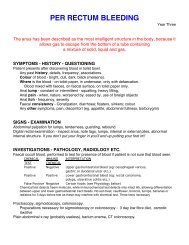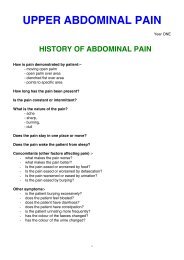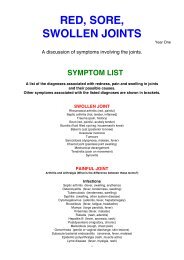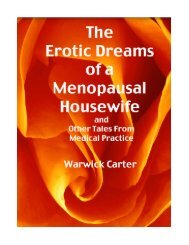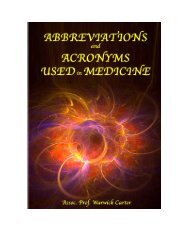Menopause A to Z.pdf - Medwords.com.au
Menopause A to Z.pdf - Medwords.com.au
Menopause A to Z.pdf - Medwords.com.au
You also want an ePaper? Increase the reach of your titles
YUMPU automatically turns print PDFs into web optimized ePapers that Google loves.
MENOPAUSE A <strong>to</strong> Z<br />
<strong>com</strong>mon headaches <strong>to</strong> fit in<strong>to</strong> this category are tension headaches, migraine and cluster headache.<br />
A tension (muscle spasm) headache c<strong>au</strong>ses a dull, persistent pain with varying intensity that is often described as a<br />
pressure or tightening around the scalp. It occurs as a localised band around and across head, and is not aggravated<br />
by exercise or alcohol. The muscles at the <strong>to</strong>p of the neck, in the forehead and over both temples go in<strong>to</strong> prolonged<br />
contraction, which tightens the scalp, c<strong>au</strong>sing pressure on the skull, and further increases the strain on the muscles.<br />
Tension headaches are episodic, often in association with stress. Depression and anxiety are <strong>com</strong>mon ac<strong>com</strong>panying<br />
symp<strong>to</strong>ms. The pain may last for 30 minutes or a week. Muscle spasm headaches usually have a c<strong>au</strong>se (eg. stress,<br />
infection, psychiatric disturbance, eye strain), and if possible this should be rectified. Simple medications such as<br />
aspirin or paracetamol, sometimes in <strong>com</strong>bination with muscle relaxants, are readily available <strong>to</strong> ease both the muscle<br />
spasm and pain. Commercially available <strong>com</strong>binations (eg. Fiorinal, Mersyndol, Panalgesic) are useful in the short<br />
term, but often c<strong>au</strong>se drowsiness. Mild heat and massaging the tense muscles will give temporary relief. Relief of<br />
chronic anxiety by talking through the problems with a doc<strong>to</strong>r or counsellor, accepting help <strong>to</strong> deal with a stressful<br />
situation, and using an anti-anxiety medication may also be useful.<br />
Migraines are often associated with visual symp<strong>to</strong>ms including flashing lights, shimmering, seeing zigzag lines and<br />
loss of part of the area of vision. They usually occur on only one side of the head, are described as throbbing, and<br />
c<strong>au</strong>se in<strong>to</strong>lerance of exercise, light and noise. N<strong>au</strong>sea and vomiting are <strong>com</strong>mon. Migraines occur periodically, and<br />
may last for a few hours <strong>to</strong> several days. The patient often looks pale and drawn.<br />
Cluster headaches are not <strong>com</strong>mon, but c<strong>au</strong>se a very characteristic pattern of headache, usually associated<br />
with excess sweating of one or both sides of head. They occur in episodes once or twice a year <strong>to</strong> c<strong>au</strong>se severe pain<br />
around or behind one eye, which spreads <strong>to</strong> a temple, the jaw, teeth or chin. They often begin during sleep, and other<br />
effects may include a red, watery eye, drooping eyelid, altered pupil in the eye, stuffy nose and flushed face. Cluster<br />
headaches may be triggered by alcohol, temperature changes, wind blowing on the face or excitement. They usually<br />
last for 15 minutes <strong>to</strong> three hours, and are named bec<strong>au</strong>se of their tendency <strong>to</strong> occur in clusters for several weeks.<br />
Many people fear that their headache may be due <strong>to</strong> a brain tumour, but this is actually very rare, most brain tumours<br />
c<strong>au</strong>sing other symp<strong>to</strong>ms that lead <strong>to</strong> their diagnosis well before a headache develops. Cancerous and benign tumours<br />
may develop not only in the brain tissue itself, but also in the other structures within the skull such as the pituitary<br />
gland, membranes around the brain (meninges), sinuses and eyes. Most brain tumours are benign and can be cured<br />
by surgery.<br />
Anything that puts abnormal pressure on the brain may c<strong>au</strong>se headaches. An abscess c<strong>au</strong>sed by an untreated<br />
infection in the brain or an injury that penetrates the skull, is one possibility. Bleeding inside the skull c<strong>au</strong>sed by an<br />
injury or rupture <strong>to</strong> a blood vessel is another. An aneurysm is the ballooning out of one side of an artery. The aneurysm<br />
may put pressure on the brain <strong>to</strong> c<strong>au</strong>se a headache, or rupture <strong>to</strong> c<strong>au</strong>se very severe effects on the brain function.<br />
Viral or bacterial infections of the brain (encephalitis) or surrounding membranes (meningitis) will almost invariably<br />
c<strong>au</strong>se a headache.<br />
21




